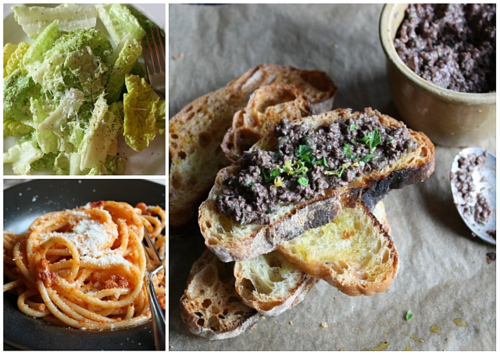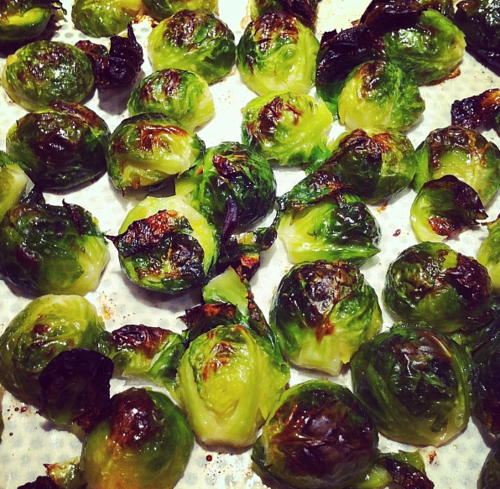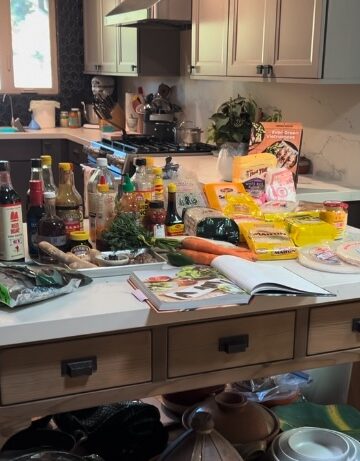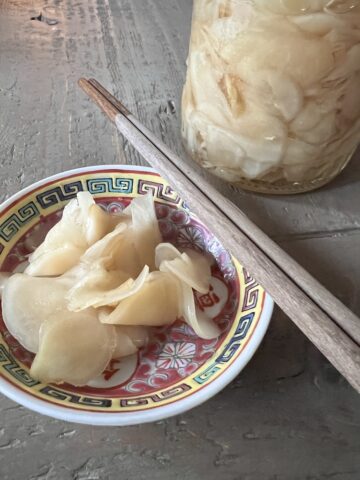
Once derided as stinky and eliciting “EEEWWW” reactions, fish sauce is having its moment in the sun, literally and figuratively. The amber red liquid made from salting and fermenting fish is no longer seen as a purely Thai or Vietnamese ingredient but as a stealth pantry item to be deployed wherever savory depth is needed. A number of professional chefs, such as Eric Ripert of Le Bernadin, have incorporated fish sauce into dishes. I use its savory, umami-ness to fix or finesse many savory dishes, not just Asian ones.
A couple of years ago in a Saveur 100 piece on Red Boat fish sauce, I wrote that I added fish sauce to my tomato-based pasta sauce. My editor at the time, Beth Kracklauer, took note of that. When she took over the food and cooking content for the Wall Street Journal, she asked me to write about non-traditional uses of fish sauce. The story was published over the weekend, and included three recipes (pictured above) for a Tuscan liver pate, Caesar salad, and pasta. It’s a full menu that employs fish sauce as a stealth ingredient for lending depth. (Beth said that story is launching a new WSJ feature called “Secret Ingredient.”)
Was I clever? Not really when you consider that I was swapping anchovies for fermented, liquid anchovies. An Italian-American friend recently revealed that she when making pasta sauces, she often included anchovies in the initial saute of garlic and other aromatics. “Don’t ever tell anyone,” Carol said in her charming New York accent.
A few weeks ago, I posted a photo of Brussels sprouts that I’d roasted on high-heat in the oven. The technique came from Molly Stevens’s marvelous Roasting cookbook, which had a brilliant recipe for “blasted broccoli.” I tossed the parboiled Brussels sprouts with a little nuoc mam before roasting. When Molly read my Facebook post, she wrote that she sometimes adds fish sauce to her blasted broccoli, after reading an earlier post I wrote. Cookbook author mind meld.

My Wall Street Journal article included reference to Mr. Lap Huynh, a dear friend of my dad’s who passed away last year in Vietnam. Mr. Lap had come to the United States in the 1970s and hustled his way to opening several noteworthy French restaurants in California. His Au Chambertin restaurants were likely the first of their kind to grab serious attention from the mainstream press.
The entire Lap family worked in the business, tirelessly Frenching green beans and arranging ornate rose petal patterns on each table. In the kitchen, Mr. Lap practiced this trick: adding fish sauce to lend oomph to his classic French menu of escargot, coq au vin and the like. In the 1980s during a visit to our home, he told my mom his secret ingredient. I was barely a teenager but listened intently. In Vietnamese, foods with umami are often described as being đậm đà (“dum dah”) – the source of that savoriness is partly fish sauce. Mr. Lap wasn't outlandish, just brazen.
Since the WSJ article was published, my father has been proudly sending the story around to friends and family. One of my cousins, Bich Tu, emailed today. She said that she’d long added nuoc mam to dishes like osso buco when she prepared it for her family. However, when she made those dishes for guests, she used anchovy paste because she was afraid that non-Viets would literally turn up their noses to the use of fish sauce in their food. After reading my story, she’s considering sticking with nuoc mam regardless of who’s eating at her table. Plus, she said anchovy paste is more expensive than fish sauce.
Bich Tu asked, “What’s the flavor difference between anchovies and fish sauce?” My experience is that fish sauce, especially one that’s on the mellow and not-so sweet side like Red Boat’s, is less assertive. It’s not intense like anchovies, which I occasionally eat on a toast round because I’m a sucker for salty, briny foods.
Fish Sauce vs. Garum
After the story came out, @missesdelicious, @txn1234567, and @natem8 tweeted me about ancient garum, liquamen, and colatura di alici. My initial sense of the Mediterranean condiments is that in the main, they may be heavier tasting than fish sauce today. On the other hand, the colatura di alici from this Italian company says it’s just anchovies and salt so maybe I’m wrong. I’ve yet to try it because nuoc mam/nam pla works for me in a borderless manner. The Asian condiment costs a lot less than its Italian counterpart ($20 for 3.3 oz / 100 ml / less than half a cup).
This post from Laura Kelley at Silk Road Gourmet includes her journey in making garum from mackerel. It’s is among the most informative out there, and she compares its taste to Southeast Asian fish sauce. Note that mackerel-based fish sauce is not considered premium in Vietnam as the fish has a very heavy, oily taste.
She’d also written about how fish sauce may have originated in the West and moved to the East but there’s no clear evidence of that. Perhaps, but if you had a lot of seafood and salt, and the need to preserve those ingredients, you’d likely gravitate toward the same preservation method. We are all human and thousands of years ago, survival cooking was key. This article from Eurasion Sensation on the origin of fish sauce is interesting.
Filtering historical information is fascinating but it can get you deep into a rabbit hole of conjecture. I’d like to just get people to use fish sauce in their home cooking. So go ahead and experiment with fish sauce. Cook in a borderless fashion.
If you already do, what's your non-Asian way of using fish sauce?
Tips for using fish sauce in non-Asian ways:
- To get over fish sauce’s pungency, take a whiff of dried porcini mushroom and compare it to that of the condiment. They’re very similar. That’s the umami talking.
- When subbing fish sauce for anchovies, a half teaspoon roughly equals one filet.
- Add fish sauce slowly to foods. Use a little at first because you can add more later.
- Use a fish sauce that’s not overly heavy, fish tasting. Viet stuff works well and not overly sweet either as that may skew your food.
Related posts and links:
- Out of the Bottle: The Magic of Fish Sauce (WSJ story)
- Premium Fish Sauce to Try
- Fish Sauce Buying Guide
- Scrambled Eggs with Fish Sauce (It’s a Viet fave)
- Blasted Broccoli with Fish Sauce
- Brussels Sprouts with Cracklings and Fish Sauce (your new holiday side?)

















Tami says
Oooh. I'll have to experiment with my next bagna cauda. 🙂
Becki's Whole Life says
This is so eye opening. I love my Thai and Vietnamese dishes with the flavor of the fish sauce - can't wait to try it in other dishes, too. The Caesar salad and pasta dish sound wonderful and so simple. The Chicken liver Pate sounds amazing too and I have been wanting to make some.
Traca says
I use fish sauce in my scrambled eggs, and often add it to soups.
Traca says
After looking at your scrambled egg recipe, mine is different. It's a mash up of various influences over the years. I melt butter and about a tablespoon of cream cheese in the bottom of the pan. Crack 3 eggs and stir in some fish sauce and sesame oil in a bowl. Stir. Then add to a pan, scrambling over low heat. If I'm feeling decadent, I'll add hot smoked salmon towards the end, and garnish with green onion.
Andrea Nguyen says
Tami, wow -- that's a great idea.
Andrea Nguyen says
Fish sauce in scrambled eggs is kinda amazing! Glad you like it too.
Andrea Nguyen says
Mine is old school, learned it from my mom. Yours sounds terrific.
Andrea Nguyen says
Yup, just a touch does the trip to add savory depth.
Alex Ong says
I'm reading this while enjoying oyster omelet (O-chien) on Jalan Alor in KL with fish sauce & lots of white pepper. Wearing shorts & melting in the heat . Talk about a perfect storm:-)
slodkokwasna.pl says
I am using the sauce to chocolate-nut cakes 😉 Yummy 🙂 Recipe soon on the blog.
Suzette says
That's so funny! I made pasta sauce last night with just passata and Italian sausage, and as I was eating it, I thought that it could use a shot of fish sauce. I just happened to be staring at a bottle of 3-crab that was on my coffee table (don't ask!), so I thought it was only a mental thing!
Andrea Nguyen says
Alex, I won't be in your motherland till early January. Will you still be there???? Or, we'll just have to get together when we're both back in the States.
Andrea Nguyen says
Really? WOW. Ping me via Twitter or email when your recipe is up.
Andrea Nguyen says
OMG -- that is a fabulous coincidence. Not a mental thing, Suzette. Just smart cooking.
Andrew says
Just found your blog! On a whim I just bought my first bottle of fish sauce (Red Boat) at the local Vietnamese market, and have been on a pomelo/squid or shrimp salad with fresh roasted peanuts and shallots binge I just ran out of pomelo and your blog gives me ideas on how I can extend the streak of days with some fish sauce goodness. Hmm... I do have everything for bagna cauda sandwich. Thanks!
Andrea Nguyen says
Wish I lived closer. It's lunch time and a bagna cauda sandwich sounds mighty fine. Thanks and welcome, Andrew.
Tami says
I just used it on eggs a few nights ago and it was amazing.
Maggie says
I don't use fish sauce, but I do love the fish-meat or fish-veg coupling common in Chinese, Spanish and some Italian dishes.
Andrea Nguyen says
Cooking surf-and-turf is a great way to go. Dried shrimp and pork -- bring it on!
jorgebob28 says
The Japanese also make a fish sauce (gyosho or shottsuru) and another one from squid. Gyosho literally means fish soy sauce.
http://www.skr-akita.or.jp/suguremono/english/shottsuru.html
Doris Gradle says
OK. We use fish sauce on popcorn, popped in a wok. Been doing this for years. The recipe is: place popcorn in coconut oil, then add a drop of fish sauce, a drop Marie Sharop's habanero pepper sauce, a drop of El Yucateco's chile habanero green sauce, a sprinkling(5 shakes) of cinnamon-cocoa mix.(we purchase the items and mix them ourselves) This is added before putting in the popcorn. After it is popped, we add salt. We never measure, so the exactness is only by taste. We eat popcorn every Sat. night. We stay in and eat the popcorn while watching a movie or playing board games. It's a tradition.